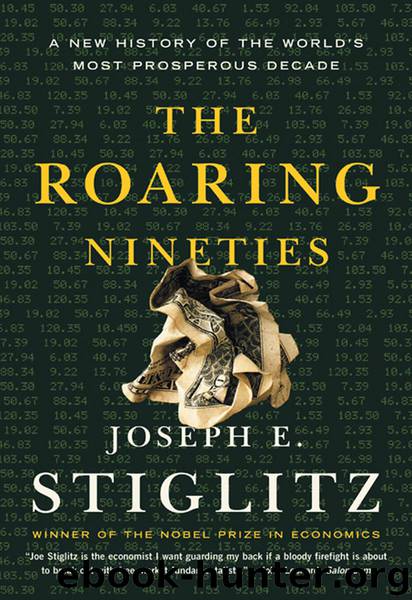The Roaring Nineties by Joseph E. Stiglitz

Author:Joseph E. Stiglitz
Language: eng
Format: epub
Publisher: W. W. Norton & Company
Published: 2003-03-22T16:00:00+00:00
CHAPTER 7
Tax Cuts
FEEDING THE FRENZY
THE BUBBLE MADE MILLIONS of Americans rich beyond their wildest dreams. But that did not necessarily invigorate them with a sense of public duty. Just as the CEOs wanted to believe that it was their acumen that had led to the prices of their company shares soaring, they wanted to believe that it was their acumen and hard work, not luck, that had led to their portfolios doing so well. They were not in a mood to share their gains, or share any more than absolutely necessary. These perceptions—combined with the politics of the moment, bad accounting, and the focus on the deficit reduction mania—led to tax policies that made the bubble worse, and its aftermath more tumultuous.
Those who had done well financially in the nineties pushed to reduce the amount of taxes they would pay on their new wealth. Their objective was to reduce the taxation on the enormous gains they were reaping, including from the stock options with which senior executives were increasingly being rewarded. With capital gains taxed still lower than dividends and other forms of income, investors were encouraged to put more of their money into the high-tech firms—which offered not dividends (many had no profits with which to pay dividends) but capital gains.
Given the focus on balancing the budget, the tax cut, as desired as it was by the wealthy (and it was the wealthy who wanted it; few of the benefits went to lower-and middle-income Americans), would not have occurred were it not for the odd mixture of bad accounting and the politics of the moment.
In 1980, Ronald Reagan promised a tax cut that would lead to an increase in tax revenue, an endeavor that even his vice president George Bush had called “Voodoo economics.” The theory was that with lower tax rates, workers would work that much harder, many more people would join the labor force, savings would increase by leaps and bounds, and these supply-side effects would generate so much more income that even at the lower tax rates, government revenue would increase. In fact, savings continued at a dismal level—even falling slightly; and there was little impact on labor supply. (Of course, some believed then, and continue to believe, that not even Reagan’s advisers really swore by voodoo economics. They had another agenda: to create deficits that would force expenditure cuts, downsizing the role of the government. In short, their agenda was advanced whether the experiment in tax cuts worked as predicted or not.)
The declining revenues (relative to what they otherwise would have been), unmatched by expenditure cuts,1 caused a decade-long fiscal crisis that Bill Clinton finally addressed in 1993.2 But, according to the accountants who oversaw the government’s books, there was one realm in which voodoo economics still worked, one realm in which one could increase tax revenues by cutting tax rates. A cut in capital gains taxes—the taxes on the increase in the value of shares and real estate—could actually increase revenues, particularly if it was temporary.
Download
This site does not store any files on its server. We only index and link to content provided by other sites. Please contact the content providers to delete copyright contents if any and email us, we'll remove relevant links or contents immediately.
The Secret History by Donna Tartt(16627)
The Social Justice Warrior Handbook by Lisa De Pasquale(11489)
Thirteen Reasons Why by Jay Asher(7788)
This Is How You Lose Her by Junot Diaz(5774)
Weapons of Math Destruction by Cathy O'Neil(5038)
Zero to One by Peter Thiel(4824)
The Myth of the Strong Leader by Archie Brown(4789)
Promise Me, Dad by Joe Biden(4449)
Beartown by Fredrik Backman(4419)
Stone's Rules by Roger Stone(4416)
How Democracies Die by Steven Levitsky & Daniel Ziblatt(4399)
The Fire Next Time by James Baldwin(4343)
100 Deadly Skills by Clint Emerson(4079)
A Higher Loyalty: Truth, Lies, and Leadership by James Comey(4033)
Rise and Kill First by Ronen Bergman(4012)
The David Icke Guide to the Global Conspiracy (and how to end it) by David Icke(3883)
The Farm by Tom Rob Smith(3872)
Secrecy World by Jake Bernstein(3783)
The Doomsday Machine by Daniel Ellsberg(3731)
